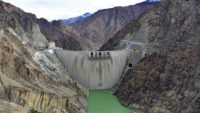Construction Safety
BLS Statistics Show Construction Fatalities Ticked Up in 2022

Fatal work injury rates per 100,000 full-time equivalent workers by selected occupational groups, 2020-22.
Chart Courtesy of the Bureau of Labor Statistics
The latest numbers from the U.S. Dept. of Labor’s Bureau of Labor Statistics show that workers in construction and extraction occupations had the second highest number of fatalities in 2022 compared to other industries.
A total of 1,056 construction workers, along with those in oil and gas and minerals extraction, died as a result of injuries on the job in 2022. BLS said the fatality rate for workers in construction and extraction increased by 11%, from 12.3 deaths per 100,000 full-time employees in 2021 to 13 in 2022.
Falls, trips and slips were the main cause for most of the deaths—423—among construction and extraction workers.
Workers in the transportation and delivery sector had the highest amount of fatalities, said BLS, driven largely by an 8% increase in the number of delivery and other truck drivers.
Other causes across all worker categories included fatalities related to extreme heat, jobsite violence and drug use. Unintentional overdoses rose 13.1% in 2022, continuing a trend of increases since 2012; fatalities due to violence increased 11.6%; and deaths caused by temperature extremes were up 18.6% compared to 2021.
The U.S. Occupational Safety and Health Administration included in its regulatory agenda in 2021 a notice that it planned to take initial steps toward regulatory action in addressing extreme heat in outdoor worksites, but any regulation on heat is likely years away, says Jordan Barab, a former deputy assistant Labor secretary for occupational safety and health. OSHA completed its Small Business Regulatory Enforcement Fairness Act process – the first step in the agency’s rulemaking process—last month.
Injuries among Latinx workers increased in 2022, with foreign-born Hispanic or Latinx workers accounting for 63.5% of their total. Fatalities among Black workers also increased between 2021 and 2022, BLS said.
Barab, who served during the Obama administration, says the uptick could partially be attributed to more "normal" working conditions post-pandemic. But he adds that OSHA typically is underfunded and understaffed.
As a result, agency staff are more often in reactive than proactive mode—more focused on responding to issues that have come up on jobsites than on making unannounced visits. That leaves many project sites—particularly in residential areas—out of the agency’s gaze.
“What I would say needs to happen to a certain extent is more eyes on the on the problem,” he told ENR.







